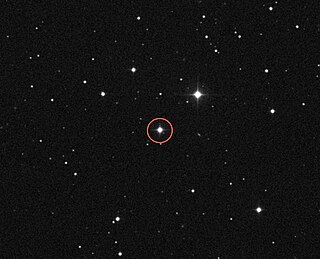글리제 445
Gliese 445좌표:![]() 11h 47m 41.3885s, +78° 41′ 28.179″
11h 47m 41.3885s, +78° 41′ 28.179″
| 관측 데이터 Epoch J2000.0 이쿼녹스 J2000.0(ICRS) | |
|---|---|
| 별자리 | 카멜로파르달리스 |
| 우측 상승 | 11h 47m 41.3885s[1] |
| 탈위임 | +78° 41′ 28.179″[1] |
| 겉보기 크기 (V) | 10.80[2] |
| 특성. | |
| 스펙트럼형 | M4.0Ve[3] |
| B-V색지수 | 1.572[2] |
| 아스트로메트리 | |
| 방사 속도 (Rv) | -1987.707km[1]/s |
| 고유 운동 (μ) | RA: 748.168mas[1]/yr Dec.: 480.804[1]mas/yr |
| 시차 (π) | 190.3251 ± 0.0194[4] 마스 |
| 거리 | 17.137 ± 0.002 ly (5.2542 ± 0.0005 pc) |
| 절대치수 (MV) | 12.227[5] |
| 세부 사항 | |
| 미사 | 0.14[6] M☉ |
| 반지름 | 0.285[5] R☉ |
| 루미도 | 0.008[7] L☉ |
| 표면 중력 (log g) | 4.72[7] cgs |
| 온도 | 3,507[1] K |
| 금속성 [Fe/H] | −0.30[5] 덱스를 만들다 |
| 회전 속도 (v sin i) | <2.5km[8]/s> |
| 기타 지정 | |
| 데이터베이스 참조 | |
| 심바드 | 자료 |
| 아리친스 | 자료 |
카멜로파르달리스자리 글리제 445의 위치 | |
글리제 445(Gl 445 또는 AC +79 3888)는 카멜로파르달리스 별자리의 북쪽에 있는 M형 주계열성이다.
위치

현재 지구에서 17.1광년 떨어져 있으며 겉보기 크기는 10.8이다.열대 암 북쪽에서 밤새도록 볼 수 있지만 육안으로는 볼 수 없다.[10]이 별은 우리 태양의 1/4에서 1/3밖에 되지 않는 질량을 가진 적색 왜성이기 때문에 과학자들은 이 시스템이 생명을 지탱하는 능력에 의문을 제기한다.[10]글리제 445도 엑스레이 소스로 알려져 있다.[11]
보이저 1호 탐사선과 글리제 445호는 약 4만년 후 1.6광년 내에 서로 통과하게 된다.[12]그때쯤이면 글리제 445는 현재의 위치와는 다른 하늘의 한 부분에 있게 될 것이다.그 탐침은 더 이상 작동하지 않을 것이다.또한 항성의 고유한 낮은 밝기를 감안할 때, 그 거리에서도 가상의 인간의 육안으로는 거의 보이지 않을 것이며, 겉보기 크기는 5.72에 불과하다.
태양 만남
보이저 탐사선이 글리제 445로부터 1.6광년 최소 거리를 향해 우주를 이동하는 동안, 이 별은 빠르게 우리 태양에 접근하고 있다.탐사선이 글리제 445를 통과할 때 이 별은 우리 태양으로부터 약 1.059파섹(3.45광년)이 될 것이지만 [13]육안으로 볼 수 있는 밝기는 절반도 되지 않는다.[10]그 때 글리제 445는 로스 248과 대략적으로 우리의 태양에 가장 가까운 별이라는 이유로 비길 것이다(가장 가까운 별 목록#미래와 과거 참조).
참고 항목
참조
- ^ a b c d e f Brown, A. G. A.; et al. (Gaia collaboration) (August 2018). "Gaia Data Release 2: Summary of the contents and survey properties". Astronomy & Astrophysics. 616. A1. arXiv:1804.09365. Bibcode:2018A&A...616A...1G. doi:10.1051/0004-6361/201833051.이 소스에 대한 가이아 DR2 기록 VizieR.
- ^ a b Urban, S. E.; Zacharias, N.; Wycoff, Observatory G. L. U. S. Naval; Washington, 2004-2006 D. C. (2004). "VizieR Online Data Catalog: The UCAC2 Bright Star Supplement (Urban+, 2006)". VizieR On-line Data Catalog. Bibcode:2004yCat.1294....0U.
- ^ Lépine, Sébastien; Hilton, Eric J.; Mann, Andrew W.; Wilde, Matthew; Rojas-Ayala, Bárbara; Cruz, Kelle L.; Gaidos, Eric (2013). "A Spectroscopic Catalog of the Brightest (J < 9) M Dwarfs in the Northern Sky". The Astronomical Journal. 145 (4): 102. arXiv:1206.5991. Bibcode:2013AJ....145..102L. doi:10.1088/0004-6256/145/4/102. S2CID 117144290.
- ^ Brown, A. G. A.; et al. (Gaia collaboration) (2021). "Gaia Early Data Release 3: Summary of the contents and survey properties". Astronomy & Astrophysics. 649: A1. arXiv:2012.01533. Bibcode:2021A&A...649A...1G. doi:10.1051/0004-6361/202039657. S2CID 227254300. 이 소스에 대한 Gaia EDR3 레코드 VizieR.
- ^ a b c Houdebine, Éric R.; Mullan, D. J.; Doyle, J. G.; de la Vieuville, Geoffroy; Butler, C. J.; Paletou, F. (2019). "The Mass-Activity Relationships in M and K Dwarfs. I. Stellar Parameters of Our Sample of M and K Dwarfs". The Astronomical Journal. 158 (2): 56. arXiv:1905.07921. Bibcode:2019AJ....158...56H. doi:10.3847/1538-3881/ab23fe. S2CID 159041104.
- ^ Gaidos, E.; Mann, A. W.; Lépine, S.; Buccino, A.; James, D.; Ansdell, M.; Petrucci, R.; Mauas, P.; Hilton, E. J. (2014). "Trumpeting M dwarfs with CONCH-SHELL: A catalogue of nearby cool host-stars for habitable exoplanets and life". Monthly Notices of the Royal Astronomical Society. 443 (3): 2561. arXiv:1406.7353. Bibcode:2014MNRAS.443.2561G. doi:10.1093/mnras/stu1313. S2CID 119234492.
- ^ a b McDonald, I.; Zijlstra, A. A.; Watson, R. A. (2017). "Fundamental parameters and infrared excesses of Tycho-Gaia stars". Monthly Notices of the Royal Astronomical Society. 471 (1): 770. arXiv:1706.02208. Bibcode:2017MNRAS.471..770M. doi:10.1093/mnras/stx1433. S2CID 73594365.
- ^ Stelzer, B.; Marino, A.; Micela, G.; López-Santiago, J.; Liefke, C. (2013). "The UV and X-ray activity of the M dwarfs within 10 pc of the Sun". Monthly Notices of the Royal Astronomical Society. 431 (3): 2063. arXiv:1302.1061. Bibcode:2013MNRAS.431.2063S. doi:10.1093/mnras/stt225. S2CID 119193975.
- ^ "GJ 445". SIMBAD. Centre de données astronomiques de Strasbourg. Retrieved July 29, 2008.
- ^ a b c Mark Littmann (1 January 2004). Planets Beyond: Discovering the Outer Solar System. Courier Corporation. ISBN 978-0-486-43602-9.
- ^ Schmitt JHMM; Fleming TA; Giampapa MS (September 1995). "The X-Ray View of the Low-Mass Stars in the Solar Neighborhood". Astrophys. J. 450 (9): 392–400. Bibcode:1995ApJ...450..392S. doi:10.1086/176149.
- ^ "NASA – Voyager - Mission - Interstellar Mission". Jet Propulsion Laboratory. Retrieved 2020-04-03.
- ^ Bobylev, Vadim V. (March 2010). "Searching for Stars Closely Encountering with the Solar System". Astronomy Letters. 36 (3): 220–226. arXiv:1003.2160. Bibcode:2010AstL...36..220B. doi:10.1134/S1063773710030060. S2CID 118374161.
외부 링크
- TYC 4553-192-1의 위키스키 이미지(글리제 445)




